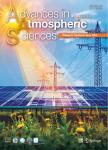A New Algorithm of Rain Type Classification for GPM Dual-Frequency Precipitation Radar in Summer Tibetan Plateau
作者机构:School of Earth and Space Sciences CMA–USTC Laboratory of Fengyun Remote SensingUniversity of Science and Technology of China Hubei Key Laboratory for Heavy Rain Monitoring and Warning Research Institute of Heavy RainChina Meteorological Administration National Satellite Meteorological CenterChina Meteorological Administration
出 版 物:《Advances in Atmospheric Sciences》 (大气科学进展)
年 卷 期:2024年第11期
页 面:2093-2111页
核心收录:
学科分类:07[理学] 070601[理学-气象学] 0706[理学-大气科学]
基 金:funded by the National Natural Science Foundation of China project (Grant Nos.42275140, 42230612, 91837310, 92037000) the Second Tibetan Plateau Scientific Expedition and Research (STEP) program(Grant No. 2019QZKK0104)
摘 要:In this study, a new rain type classification algorithm for the Dual-Frequency Precipitation Radar(DPR) suitable over the Tibetan Plateau(TP) was proposed by analyzing Global Precipitation Measurement(GPM) DPR Level-2 data in summer from 2014 to 2020. It was found that the DPR rain type classification algorithm(simply called DPR algorithm) has mis-identification problems in two aspects in summer TP. In the new algorithm of rain type classification in summer TP,four rain types are classified by using new thresholds, such as the maximum reflectivity factor, the difference between the maximum reflectivity factor and the background maximum reflectivity factor, and the echo top height. In the threshold of the maximum reflectivity factors, 30 d BZ and 18 d BZ are both thresholds to separate strong convective precipitation, weak convective precipitation and weak precipitation. The results illustrate obvious differences of radar reflectivity factor and vertical velocity among the three rain types in summer TP, such as the reflectivity factor of most strong convective precipitation distributes from 15 d BZ to near 35 d BZ from 4 km to 13 km, and increases almost linearly with the decrease in height. For most weak convective precipitation, the reflectivity factor distributes from 15 d BZ to 28 d BZ with the height from 4 km to 9 km. For weak precipitation, the reflectivity factor mainly distributes in range of 15–25 d BZ with height within 4–10 km. It is also shows that weak precipitation is the dominant rain type in summer TP, accounting for 40%–80%,followed by weak convective precipitation(25%–40%), and strong convective precipitation has the least proportion(less than 30%).



